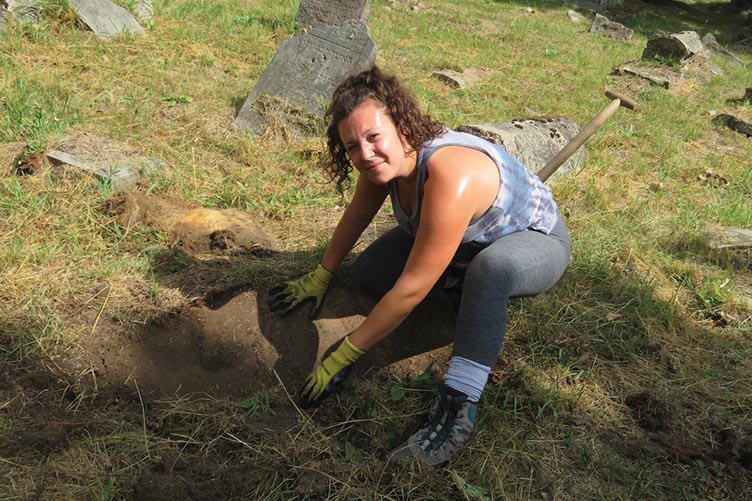
Courtesy Photo
Much of the Bagnowka Jewish Cemetery in Bialystok, Poland, is invisible at first glance: It looks like an unmowed lumpy field surrounded by forest. But if you poke 5-6 inches beneath the surface, you’ll find seemingly ancient gravestones hidden in the tundra. Miraculously, some toppled gravestones come out of the earth intact. Many others are shattered in pieces, have been covered by moss or are entangled in tree roots.
For the past two summers, Ali Flagler ’17 has helped bring dignity and visibility to this sacred space as a volunteer for the Bialystok Cemetery Restoration Project. The grassroots charitable organization is dedicated to repairing the neglected cemetery first desecrated by the Nazis 80 years ago and later looted by the Communist government and local farmers who reused Jewish gravestones as building materials for roads, sidewalks and barn foundations.
As part of the ugly aftermath of the Holocaust, there are numerous Jewish cemeteries in similar dire conditions across Eastern Europe. Countless others have disappeared entirely, bulldozed and developed for real estate or public parks. Flagler and her fellow volunteers know they cannot undo the horrors of the past but feel that every gravestone they can restore is “righting a wrong,” and is worth doing for its own sake.
“Whether it’s scrubbing a stone, painting the letters or just pulling it out of the ground and reading the person’s name out loud, I just picture them dancing in my head,” she says. “This work is about bringing their souls back to life. It’s really restoring their memory in a place where they probably look down and thought all hope was lost.”
Bialystok is an industrial city of 300,000 near the Belarus and Lithuania borders. Before World War II, 50 percent of the greater Bialystok region’s population was Jewish. Today that figure is zero percent. After the German invasion of Poland in 1939, the Nazis forced the Jewish community into a ghetto and murdered most of the population at the nearby Treblinka concentration camp.
“Even having our footsteps in the cemetery after no one has visited it for so long is breathing life back into it,” says Flagler, who works as a data analyst for Liberty Mutual in Dover. “I’m grateful for having this experience. I think volunteering there has helped shaped me as a young adult.”
Flagler credits her parents Howard (a former social worker) and Paula Flagler (a retired school teacher) for influencing her to pursue volunteer work as a lifelong passion. The senior Flaglers both serve on the board of directors of the Bialystok Cemetery Restoration Project and invited their daughter to join them in Poland in 2017 after she graduated from UNH.
During that initial volunteer experience in Bialystok, Flagler discovered a rare style of tombstone not previously found in the region. Later affectionately referred to as the “Ali stone” by her peers, the small square gravestone with ornately painted Hebrew letters was believed to be used as an affordable alternative for people who could not pay for engraved lettering.
“I kind of feel embarrassed to even say ’Ali stone’ out loud because I can’t take credit for it,” Flagler says. “And we’re remembering someone’s soul. It’s incredible how well the paint was preserved while buried in the ground, but more importantly, this person will now be remembered after being forgotten for so long.”
Flagler, who will return for her third summer in Bialystok this August, says she’s starting to learn more about her ancestry — which may or may not intersect with the cemetery she’s come to love. "I know I have definite family ties to Poland, but we haven’t found any specific connection to Bialystok. That doesn’t matter to me, though. With every stone, I’m helping to honor the lives of someone else’s family, and we have so much more to do.”
For more information on the Bialystok Cemetery Restoration Project and how you can help, visit http://bialystokcemeteryrestoration.org
-
Written By:
Darren Garnick | Freelance Writer

















































